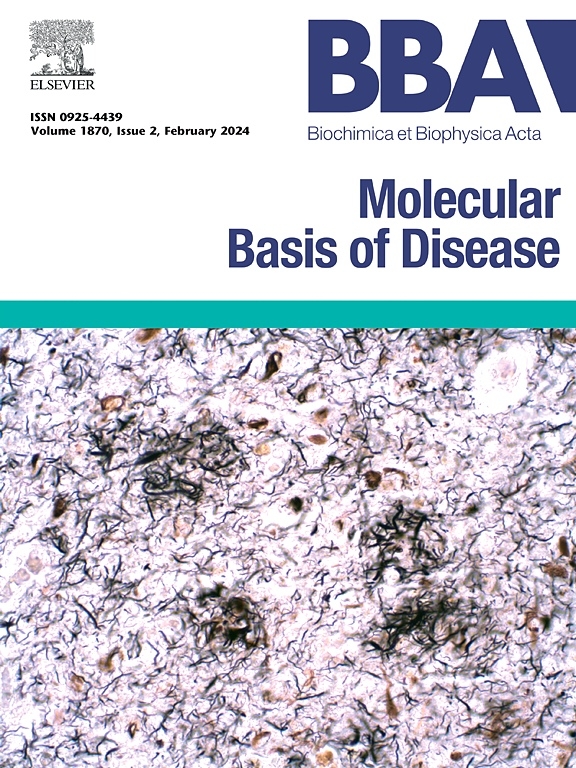Nrf2对草鱼肝脏血红蛋白氧化损伤具有保护作用。
IF 4.2
2区 生物学
Q2 BIOCHEMISTRY & MOLECULAR BIOLOGY
Biochimica et biophysica acta. Molecular basis of disease
Pub Date : 2024-11-29
DOI:10.1016/j.bbadis.2024.167600
引用次数: 0
摘要
血红蛋白(Hb)在出血过程中释放并引起氧化损伤,进一步加剧了多种疾病的发展。核因子红细胞2相关因子2 (Nrf2)是一种调节细胞防御毒性和氧化挑战的转录因子。然而,在硬骨鱼中,Nrf2在hb诱导的氧化应激中的调控机制尚不清楚。为此,通过给草鱼注射苯丙氨酸(phenylalanine, PHZ)建立溶血模型,免疫荧光分析(IFA)和苏木精伊红(hematoxylin and eosin, H&E)染色显示,PHZ诱导的溶血导致Hb积聚和肝脏空泡形成,导致组织损伤。普鲁士蓝、天狼星红和马松染色结果显示肝脏中明显的铁沉积和广泛的胶原纤维积累。IFA和免疫组织化学分析表明,phz诱导的溶血显著增加了活性氧(ROS)、丙二醛(MDA)和4-羟基壬烯醛(4-HNE)的产生。实时荧光定量PCR (qRT-PCR)分析数据显示,phz诱导的溶血还通过激活腺苷5′-单磷酸腺苷(AMP)活化蛋白激酶(AMPK)/Nrf2信号通路,显著上调抗氧化相关基因的表达。为了进一步探讨PHZ诱导溶血的分子调控机制,我们进行了RNA-seq分析,数据显示PHZ注射组AMPK/Nrf2及铁坏死、自噬、凋亡、坏死等多种程序性细胞死亡通路显著上调。在体外,补充hemin激活了qRT-PCR检测的AMPK/Nrf2通路靶基因的表达。为了进一步验证Nrf2的调控功能,我们补充了Nrf2激活因子(4OI),流式细胞仪分析结果显示,hb诱导的细胞损伤明显减弱。而补充ML385可下调AMPK/Nrf2通路,加重hemin诱导的细胞死亡。总之,这些发现强调了AMPK/Nrf2信号通路在保护草鱼肝脏免受hb诱导的氧化损伤中的关键调节作用。本文章由计算机程序翻译,如有差异,请以英文原文为准。

Nrf2 protects against oxidative damage induced by hemoglobin in the liver of grass carp (Ctenopharyngodon idella)
Hemoglobin (Hb) releases during hemorrhaging and causes oxidative damage, further exacerbates the development of multiple diseases. Nuclear factor erythroid 2–related factor 2 (Nrf2) is a transcription factor that regulates cellular defenses against toxic and oxidative challenges. However, the regulation mechanism of Nrf2 in Hb-induced oxidative stress remains unclear in teleost. To accomplish this goal, a hemolysis model was established by injecting grass carp with phenylalanine (PHZ), and the immunofluorescence analysis (IFA) and hematoxylin and eosin (H&E) staining revealed that PHZ-induced hemolysis caused Hb accumulation and hepatic vacuolization, resulted in tissue damage. Prussian blue, Sirius red, and Masson staining results revealed significant iron deposition and extensive collagen fiber accumulation in the liver. IFA and immunohistochemical analyses demonstrated that PHZ-induced hemolysis markedly increased the production of reactive oxygen species (ROS), malondialdehyde (MDA), and 4-hydroxynonenal (4-HNE). The quantitative real-time PCR (qRT-PCR) analysis data revealed that the PHZ-induced hemolysis also significantly upregulated the expression of antioxidant-related genes through activation of the adenosine 5′-monophosphate (AMP)-activated protein kinase (AMPK)/Nrf2 signaling pathway. To further explore the molecule regulation mechanism of PHZ-induced hemolysis, the RNA-seq analysis was performed, and the data revealed that the AMPK/Nrf2 and multiple programmed cell death pathways, including ferroptosis, autophagy, apoptosis, and necroptosis in PHZ injection groups were significant upregulated. In vitro, the hemin supplementation activated the expression of target genes in the AMPK/Nrf2 pathway detected by qRT-PCR. To further verify the regulation function of Nrf2, an Nrf2 activator (4OI) was supplemented, and the flow cytometer analysis results suggested that the Hb-induced cell damage was significantly attenuated. However, the supplementary of ML385 down-regulated the AMPK/Nrf2 pathway and aggravated the hemin induced cell death. In conclusion, these findings highlight the critical regulatory role of the AMPK/Nrf2 signaling pathway in protecting against Hb-induced oxidative damage in the liver of grass carp.
求助全文
通过发布文献求助,成功后即可免费获取论文全文。
去求助
来源期刊
CiteScore
12.30
自引率
0.00%
发文量
218
审稿时长
32 days
期刊介绍:
BBA Molecular Basis of Disease addresses the biochemistry and molecular genetics of disease processes and models of human disease. This journal covers aspects of aging, cancer, metabolic-, neurological-, and immunological-based disease. Manuscripts focused on using animal models to elucidate biochemical and mechanistic insight in each of these conditions, are particularly encouraged. Manuscripts should emphasize the underlying mechanisms of disease pathways and provide novel contributions to the understanding and/or treatment of these disorders. Highly descriptive and method development submissions may be declined without full review. The submission of uninvited reviews to BBA - Molecular Basis of Disease is strongly discouraged, and any such uninvited review should be accompanied by a coverletter outlining the compelling reasons why the review should be considered.

 求助内容:
求助内容: 应助结果提醒方式:
应助结果提醒方式:


